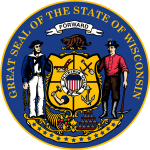|
1918 United States Senate special election in Wisconsin
The 1918 United States Senate special election in Wisconsin was held on April 2, 1918. Incumbent Democrat Senator Paul O. Husting was killed in a hunting accident the previous year. Republican U.S. Representative Irvine Lenroot defeated Democratic Federal Trade Commission Chairman Joseph E. Davies and Socialist former Congressman Victor L. Berger. Primary elections were held on March 19.[1] Davies easily defeated progressive reformer Charles McCarthy for the Democratic nomination, while Lenroot narrowly defeated James Thompson, a progressive district attorney and ally of Senator Robert M. La Follette, for the Republican nomination by a margin of less than three thousand votes. BackgroundIncumbent Senator Paul O. Husting was shot and killed by his brother Gustav in a hunting accident on October 21, 1917.[2] Husting had been elected in 1914 and his term in office was set to expire in 1921. A special election to complete Husting's unexpired term was scheduled for April 2, 1918. Although Governor Emanuel L. Philipp had the power under Wisconsin law to appoint a temporary successor until one could be duly elected,[2] the seat remained vacant until the election. The election held national importance because following Husting's death, the United States Senate was composed of 48 Republicans and 47 Democrats. Thus, whichever party won the Wisconsin special election would control the Senate for the remainder of the 65th United States Congress.[a] The election was also held during wartime, as the United States had formally entered into World War I on April 6, 1917, and major U.S. operations in Europe were set to begin in the summer of 1918. Wisconsin, a state long defined by its progressive politics and home to a large ethnically German population, had been branded a "hotbed of sedition."[3] Democratic primaryCandidates
CampaignJoseph E. Davies ran at the personal request of President Woodrow Wilson, who hoped to win the seat and thus control of the Senate for his party. Davies, who had run Wilson's campaign in the Midwest in 1916, resigned from the new Federal Trade Commission to join the race.[4] Results
Republican primaryCandidates
Results
Socialist primaryCandidates
CampaignBerger, a leader of the Socialist Party in Milwaukee and of its national pragmatic wing, faced no opposition from within his party for the nomination for Senator. For him, most of the primary campaign was focused on opposition from federal law enforcement. Berger dismissed the war as "a capitalist war caused chiefly by the struggle between Great Britain and Germany for the world market"[3] and published several editorials opposing American entry in his newspaper, the Milwaukee Leader. In the fall of 1917, federal authorities revoked the Leader's second-class mailing privileges.[3] Shortly before the primary in February, Berger and three other Socialists were indicted for alleged violations of the Espionage Act. Nevertheless, he remained in the race and advanced to the general election.[3] Results
General electionCandidates
CampaignBerger ran on the Socialist platform with his calls for protection of "freedom of speech, freedom of press and freedom of assemblage," which received increased attention in light of his indictment.[3] His Socialist platform also called for "an early, general, lasting and democratic peace," "compelling the profiteers of the war to pay the cost of the war," and "national ownership of trusts and ... public ownership of public utilities."[3] Results
References
|
|||||||||||||||||||||||||||||||||||||||||||||||||||||||||||||||||||||||||||||||||||||||||||||||||||||||||||||||||||||||||||||||||||||||||||||||




